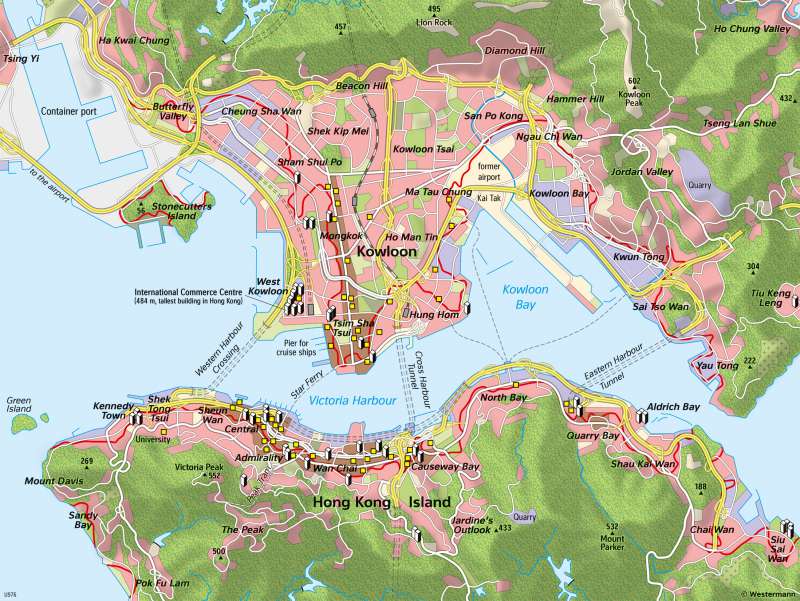Hong Kong - Cityscape
Economic development and urbanisation
978-3-14-100890-6 | Page 126 | Ill. 2

Overview
Hong Kong is a special administrative region of China and a former British colony. Hong Kong borders the Guangdong Province to the north and is otherwise surrounded by the South China Sea.
Development of Hong Kong
Hong Kong is composed of Hong Kong Island in the south, the Kowloon Peninsula, the New Territories in the north, which Britain once leased from China, Lantau Island and 230 other mostly uninhabited islands. After losing wars in the 19th century, the Chinese government had to cede "Hong Kong Island" and "Kowloon" to Great Britain. On 19 December 1984, a treaty was agreed to return them to China on 1 July 1997. With the return to China, many Hong Kong residents were concerned that their liberties would also be severely restricted by the Chinese government. In fact, China has been exerting increasing pressure on the media and politics in recent years, leading to prolonged mass protests in Hong Kong.
Dealing with the lack of space
Hong Kong's coastline is very mountainous and rugged and only partially suitable for the construction of buildings and infrastructure. Nevertheless, about 7.47 million people live on just 1100 square kilometres. By 2026, an increase to 7.74 million people is forecast. Hong Kong has always been a popular destination for migrants and refugees seeking political freedom and economic success.
In order to provide enough living space for the people, it was necessary to build vertical. After the Second World War, huge satellite towns were built and almost exclusively high-rise buildings were erected. 50 to 60 storeys are no exception. But the shortage remains, so that even normal wage earners can often only afford small flats. To counteract the lack of space, there have been numerous land fills along the coast, because the mountainous hinterland is also unsuitable for housing construction.
In addition, Hong Kong is a popular tourist destination. In 2019, 56 million people visited the city, equalling almost 8 tourists per inhabitant. The city ranked 10th position in the world. Huge areas were also filled up to create tourist infrastructure and attractions; for example, for "Hong Kong Disneyland". In total, Hong Kong's tourism generated revenues of about 29.2 billion euros in 2019, which corresponds to 9.6 per cent of the gross domestic product.
Links (as of Sept. 14, 2021):
https://de.statista.com/statistik/daten/studie/322305/umfrage/gesamtbevoelkerung-von-hongkong/
https://www.planet-wissen.de/kultur/metropolen/hongkong/index.html
https://www.handelsblatt.com/unternehmen/handel-konsumgueter/shanghai-hongkong-singapur-die-groessten-containerhaefen-der-welt-2021/25245228.html?ticket=ST-9088551-9d0GEAaKTuCh1VC0bqKH-ap3
https://www.laenderdaten.info/Asien/Hongkong/tourismus.php
https://www.britannica.com/place/Hong-Kong
Trade and financial centre
Hong Kong's geographical location provides perfect conditions for a protected natural harbour. After the trade in opium, which led to wealth in Hong Kong under the British flag, goods of all kinds were handled at the port. Today, Hong Kong ranks 9th with the world's largest container ports by throughput (2020: 18 million TEU, a decrease of 300,000 TEU compared to 2019).
As early as the mid-19th century, in 1865, Hong Kong gained a second economic pillar: the "Hong Kong & Shanghai Banking Corporation Ltd." was established as the first bank. Attracted by low taxes and customs duties, hundreds of banks settled in Hong Kong's Central Business District. This also included the construction of more spectacular skyscrapers. An advantage for the financial and trading centre is also the well-developed infrastructure and the short distances. For lack of space, the new airport, which opened in 1998, was built on a completely artificial island. However, the production of cheap goods, for which Hong Kong was once known (labelled “Made in Hong Kongâ€), was outsourced mostly to the rapidly developing neighbouring industrial city of Shenzhen under British rule.
Author:
Sarah Franz




